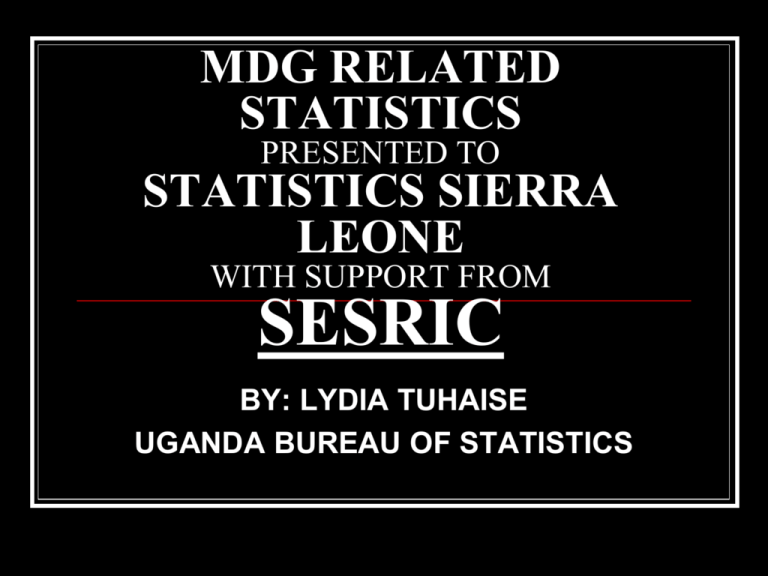Overview on Data Management - OIC Statistical Commission
advertisement

MDG RELATED STATISTICS PRESENTED TO STATISTICS SIERRA LEONE WITH SUPPORT FROM SESRIC BY: LYDIA TUHAISE UGANDA BUREAU OF STATISTICS BACKGROUND TO STATISTICS Session Objectives To discuss the development and meaning of statistics To justify the importance of reliable and timely statistics in planning To introduce some key statistical concepts Background to Statistics Meaning of statistics Development of statistics Major sources of statistics Uses of statistics Key statistical concepts Data types Data analysis Meaning of Statistics 1. The word statistics is used in either two senses. Commonly used to refer to data. Principles and methods which have been developed for handling numerical data. 2. Statistics is defined as a branch of mathematics or science that deals with the collection, analysis and interpretation of numerical information. Meaning of Statistics contd… 3. Statistics changes numbers into information. 4. Statistics is the art and science of deciding: what are the appropriate data to collect, deciding how to collect data efficiently using data to give information, using data to answer questions, using data to make decisions. Meaning of Statistics contd… 5. Statistics” are data obtained by collecting, processing, compiling, analyzing, publishing and disseminating results, gathered from respondents through statistical collections or from administrative data 6. Statistics is making decisions when there is uncertainty. We have to make decisions all the time, in everyday life, as part of our jobs. Meaning of Statistics contd… 7. Statistics is a mathematical science pertaining to the collection, analysis, interpretation or explanation, and presentation of data. Meaning of Statistics contd… 8. Statistics are used for making informed decisions and misused for other reasons 9. Statistics is the science of learning from data. A Quote “When you can measure what you are speaking about and express it in numbers, you know something about it; but when you cannot measure it, when you cannot express it in numbers, your knowledge is of the meager and unsatisfactory kind’, Lord Kelvin (British physicist) Development of Statistics The word statistics is believed to have been derived from the word “states”. The administration of states required the collection and analysis of data of population and wealth for the purpose of war and finance. Development of Statistics contd... Some concepts of statistics were developed by students of games of chance, such games lean on probability. The fertile grounds for application and development of statistical methods included; insurance, biology and other natural sciences. To date, there is hardly any discipline which does not find statistics useful. Economics, sociology, business, agriculture, health and education; all lean heavily upon statistics. Sources of data 1. Primary sources. Censuses Surveys Experiments The great advantage of such data is that the exact information wanted is obtained. Sources of data contd…. Secondary Sources. Often data is picked from reports and publications of researchers, institutions and organizations. Such data is referred to as secondary. Uses of statistics Statistics is a discipline which was developed to extract relevant facts from a large body of information and to help people make decisions when uncertainty exists concerning the information. Statistics form the basis for planning. Statistics provide information and data (facts and figures) as an input for planning, monitoring and evaluation of programmes. Population (1948 - 2008)- million 29.6 24.2 16.7 12.6 9.5 5 1948 6.5 1959 1969 1980 1991 2002 2008 Poverty levels Po (%) % of the population below the poverty line 56 44 34 1992 1997 1999/00 Poverty Line US$1 per day per adult equivalent 38 31 2002/03 2005/06 Overview on Data Management Data management cycle Design questionnaire Design survey Conception Reporting of results Data analysis Enumerators collect data in the field Manual checking, editing etc. Data entered onto computer Computer data management PLANNING THE SURVEY Identify the relevant Indicators Check to ensure the existence of an appropriate Sampling Frame Choose the Sample Design [Methodology] Determine the Sample size and the associated cost of the survey Train data collectors Determine how to collect, process, and analyse the data PLANNING THE SURVEY...Contd Determine the work-plan closely linking it to the budget. Consider the financial, material, and human resource available All these must be well perceived and well arranged at this stage. A failure can derail the survey. Data collection Data could be collected by: conducting a census conducting a sample survey use of administrative records conducting experiments observation and review of secondary sources STEPS IN DATA COLLECTION STEP 1 Formulate the problem Develop objectives of data collection Plan, human resource, logistics, scheduling, budgeting Discuss with stakeholders STEPS OF DATA COLLECTION …Contd STEP 2 Determine sources of information Define approach to data collection Identify concepts, definitions and classifications to be used STEPS OF DATA COLLECTION …Contd STEP 3: Determine techniques of data collection Determine best approach to data collection STEPS OF DATA COLLECTION …Contd STEP 4: Prepare data collection forms Design data collection forms STEPS OF DATA COLLECTION …Contd STEP 5: Pretest data collection instruments Collect some information to refine the questionnaire/ data collection form. Determine feasibility of obtaining data STEPS OF DATA COLLECTION …Contd STEP 6: Finalise data collection forms Discuss final questionnaire/form with stakeholders and reproduce questionnaires/forms STEPS OF DATA COLLECTION …Contd STEP 7: Collect data Put in place a team of data collectors/ fieldworkers Train data collectors DATA COLLECTION TECHNIQUES Data collection techniques allow us to systematically collect information about our objects of study; and about the setting in which they occur. Data collection techniques generate both qualitative and quantitative data. DATA COLLECTION … Contd Qualitative techniques of data collection involve the identification and exploration of a number of related variables for in-depth understanding of the phenomena. Qualitative data is often recorded in a narrative form. DATA COLLECTION … Contd Quantitative techniques of data collection are used to generate quantifiable data. Both qualitative and quantitative techniques are often used in a single study, since the two compliment each other. QUALITATIVE METHODS The qualitative methods most commonly used in evaluation can be classified in three broad categories: In-depth interview Observation methods Document review QUALITATIVE METHODS …Contd These methods are characterized by the following attributes: They tend to be open-ended and have less structured protocols They rely more heavily on interactive interviews; QUALITATIVE METHODS …Contd They use triangulation to increase the credibility of their findings Generally, their findings are not generalizable to any specific population SOME QUALITATIVE METHODS In-Depth interview Participant observation Direct observation Document/literature review QUANTITATIVE METHODS Typical quantitative data gathering strategies include: Experiments/clinical trials. Observing and recording well-defined events (e.g., counting the number of patients waiting in emergency at specified times of the day). QUANTITATIVE METHODS … Contd Obtaining relevant data from management information systems. Administering surveys with closed-ended questions COMPILATION AND ANALYSIS STEPS Cleaning and organizing the data for analysis (Data Preparation) Describing the data (Descriptive Statistics) Testing Hypotheses and Models (Inferential Statistics) SOME STATISTICAL CONCEPTS Population Sample Parameter Statistic Variable Estimation Data Types DATA TYPES Qualitative Quantitative Nominal Continuous Ordinal Discrete Binary DATA PREPARATION Checking the data for completeness accuracy Preparing data entry screen Entering the data into the computer Transforming the data DATA PRESENTATTION AND DESCRIPTION Used to describe the basic features of the data in a study DATA PRESENTATION Graphical Histograms Bar charts Pie charts Error bars More…. PRESENTATION … Contd Tabular Frequency tables Percentages TYPES OF STATICTICS A- Descriptive statistics B – Relational Statistics Univariate, bi-variate, and multi-variate analysis C- Inferential statistics Branch of statistics devoted to making generalizations. DATA DESCRIPTION They provide simple summaries about the sample and the measures. Simply describing what is; what the data shows DESCRIPTION … Contd Measures of Central Tendency Mean, median, mode Measures of Dispersion Variation HOW TO DESCRIBE DATA WELL Look at the oddities in the data and be prepared to adapt the summaries you calculate Look at the data using tables and graphs Understand how to summarise the categorical variables Understand how to summarise the numerical variables Identify any structure in your data and use it to summarise your data INFERENTIAL STATISTICS Investigate questions, models and hypotheses. Confidence Intervals Hypothesis testing THANK YOU






